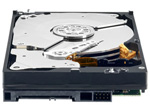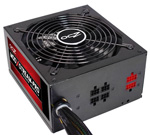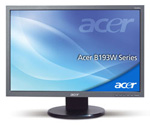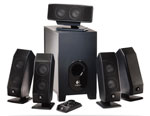Value Midrange Common Components
AMD and Intel architectures differ in sockets and sometimes memory configurations, but there is more in common than not between the two systems. For that reason the Intel and AMD value midrange systems share a number of components.
 |
The video card choice is an upgrade from the last midrange guide. The choice three months ago was the ATI 4850 512MB, but today we can recommend the ATI 4870 1GB for about the same price. The HIS H487FN1GP 1GB is just $130 after a $20 rebate. That excellent value made this card the video choice for both the Intel and AMD systems. Even without the rebate you can now find a 1GB 4870 for around $150. Our recent graphics card buyers' guide recommended the 4850 512MB as the best value in the $130 to $150 price range. Now you can spend the same $130 to $150 and get a more powerful 4870 with double the video memory. You will certainly be happy with the gaming capabilities of the 4870; it is an excellent match to the true HD video resolution of the 23" monitor chosen for the value midrange systems.
On the Intel system, the GIGABYTE GA-EP45-UD3P motherboard provides a second PCI x16 slot. Video performance can be improved even further by adding a second Radeon HD 4870 1GB in CrossFire mode. You can also upgrade to the 4890 1GB for more power at higher resolutions with "eye candy" turned on. The 4890 1GB upgrade adds about $50. The motherboard choice for AMD is the GIGABYTE GA-MA790X-UD4P, which also provides multiple x16 slots for CrossFire, although the two slots each run at x8 when both are populated. The same video options apply to the AMD value midrange system.
 |
1TB hard drives are now a routine hard drive capacity. The 1TB drives are large, fast, and stable, so it was easy to recommend the Western Digital Caviar Black 1TB drive (1000GB) at $95. There are cheaper 1TB drives available and there are many brands available with 1TB capacity. However, the Caviar Black has earned an enviable reputation for stability and performance. While there are differences between hard drives, outside of running benchmarks most people aren't likely to notice the difference in performance between Western Digital, Seagate, Samsung, Hitachi, and other major brands. All are worthy of consideration if the price per gigabyte (or terabyte) is right.
 |
Since many readers complained that Blu-Ray playback was an unnecessary expense in a value midrange system, we downgraded the optical drive to a fast DVD burner. Fortunately, DVD burners have just seen the introduction of faster burning speeds and the Sony Optiarc 24X has emerged as a favorite in recent system builds. This Sony DVD burner is the choice for both best value midrange systems. It can burn DVDs as fast as 24x speed and it supports both single and double layer media. If you like the ability to read 25GB/50GB Blu-Ray disks you can upgrade to the LG CH08LS10 Blu-Ray/DVD combo drive used in the performance midrange systems. Adding that capability increases the cost about $100.
Cases are often very personal choices when it comes to features, and you may already have a favorite. If you don't you should definitely look at the recommended Antec Three Hundred. The Three Hundred is a bottom-mount power supply design. Some love this configuration, others hate it, but it works well in the Three Hundred. It is definitely reasonable at the current $60 cost, but that does not mean it is a "cheap" case. It comes standard with a 120mm rear exhaust fan and a 140mm top fan, which both feature a 3-speed switch. There is also room to mount two additional front 120mm fans behind a washable dust filter, so you can effectively cool anything from a single hard drive to a large RAID array. Inside there are nine drive bays - six internal 3.5" and three external 5.25" drive bays. Front USB, headphone, and microphone jacks are also standard and they are conveniently located at the top of the front panel. That makes them usable in the common "on the floor" setup.
If you prefer a more traditional case configuration the Cooler Master Mystique, selling for $80, mounts the PS on top, provides font panel jacks, and is loaded with expansion ports and two 120mm fans.
 |
The Editors' Choice BFG Tech LS-550 power supply has been discontinued. The new power supply choice for the value midrange systems is the excellent OCZ ModXStream Pro 600W. The ModXStream is 80 Plus certified and a modular design. That means you use only the cables you need for your system, which makes cable management a much easier task. This OCZ is also a great value right now at $60 after a $20 rebate. The PSU is also SLI certified and CrossFire Ready.
 |
The last major component to discuss is the display, and here the tilt was toward best value at full 1080p HD (1920x1080) resolution. Six months ago we chose a "new class" of 16:9 21.5" LCD monitors that provided true 1080p resolution at the then break-through price of just $199. Now we can choose a larger Acer 23" (nominal 24") monitor for even less at $180. It is also worth mentioning that the Acer 23" is one of the few monitors in its class that comes with all three video cables. Yes, an HDMI cable is included in the Acer box. Some buyers want the cheapest monitor they can find. The ASUS 21.5" chosen in earlier Buyers' Guides is now $149 after a $10 rebate. The resolution is the same as the Acer 23". Choosing the ASUS 21.5" instead saves you about $30 for those on a tight budget, with a reduction in pixel pitch from 0.271mm to 0.248mm.
 |
The Logitech X-540 has been a favorite of users looking for a reasonably priced but good performing, powered 5.1 computer speaker system. At $79 it will certainly not challenge the performance of a separate Dolby amplifier powering audiophile speakers, but it will provide surprisingly good sound for the price. The Creative Inspire T6100 76W 5.1 speaker system is a similar powered speaker system that is selling at about the same price as the X-540. Either speaker system is a good choice for these value midrange builds.
These are clearly desktop systems, so the keyboard and optical mouse are the basic Microsoft OEM kit. If you have specific needs or a favorite gaming mouse, you likely know exactly what you prefer. The Microsoft pair is very capable for most. For greatest compatibility we have chosen Microsoft Vista Home Premium OEM as the operating system. Unless you have specific networking and special enterprise security needs there is no real reason to pay the extra for Vista Ultimate.










71 Comments
View All Comments
ChrisOjeda - Monday, July 27, 2009 - link
Will onboard video (like ASUS M4A78T-E) be a solid solution for somebody that does no gaming, but would like to make a home theatre box for watching movies, playing music, and viewing pictures using a Windows solution. I have no intention of gaming on the machine and don't want to spend more than necessary for a video card. Assume all other components the same.JarredWalton - Monday, July 27, 2009 - link
Yes. If you're a stickler for audio, make sure it's an IGP that can handle multi-channel LPCM audio output. NVIDIA has had this for a while, Intel added it a year or so back, and http://www.anandtech.com/weblog/showpost.aspx?i=62...">AMD just added it with the R785 (HD 4200).garydale - Monday, July 27, 2009 - link
The AMD 790GX chip does pretty reasonable graphics for the non-gamer so I went with the Gigabyte GA790GP-UD4H (or some similar number) board. The six onboard SATA2 ports meant that my software RAID 5 array (4 x 500G) still allowed me to plug in a SATA DVD rewriter.With a Phenom II 940 processor, the total build (less monitor - still using an old Dell 21" trinitron) was pretty small. I found a 470watt PC Power & Cooling Silencer on sale last year and stuffed it in a case I'd picked up years ago.
The processor runs quite cool thanks to the new cooler AMD puts on them - about the same temp I was getting with with an earlier Phenom X4 and a Gladiator Max cooler. It's the hard drives that are running hot, so I'll need to add another fan at the back to pump more hot air out.
Just waiting for the Blu-ray burner costs to come down. They haven't really moved in the last year, which is disappointing. Does anyone have any idea on why the prices are staying high? I notice the media prices have been dropping, so when can we expect a $100 Blu-ray burner?
goinginstyle - Monday, July 27, 2009 - link
I was surprised that I did not see a AMD 770 or cheap Intel P45 based system with the 4890 as the video card choice for the midrange system. The money you save on the board allows you to upgrade the video card choice and performance looks to be the same. Maybe overclocking is not as good but does it really matter that much.You end up with a single video card on the board but it also allows you to save money on the power supply choice, which might get you a better audio selection or two hard drives. I think having alternatives listed in these guides would be good, otherwise most of the choices were solid.
brybir - Monday, July 27, 2009 - link
I was looking for the 780G as well. I think they were looking for "gamer" boards with the option to Crossfire or SLI or whatnot over strictly budget options since this is a "middle of the road" system guide for both casual gamer types as well as those in the upper end of the price range who want very good system speed.If I were building a mid range system (I am going to build one come early 2010 when Intel's i5 line is more flushed out and the new gen of graphics cards are released in oct/now) I would probably pick up a 780G board and use the money to go from the 4870 to the 4890 or even just use the money for a bump in LCD quality.
Black Jacque - Monday, July 27, 2009 - link
This article makes some good points in graphics and CPU selection. However, it shows the Editors have a poor understanding of PC power consumption.By reasonable accounts, all the PSUs in the recommended systems have twice the rated wattage that the parts lists will draw at full core-burning maximum. For the mid-range, a 400W-450W PSU is more than enough.
The recent, excellent Xbit Labs article "PC Power Consumption: How Many Watts Do We Need?" clearly illustrates that 750W PSUs are a waste of money in the mid-range when not going with SLI or Crossfire. This article shows the trend in PC parts is downward in power consumption.
When building a mid-range machine, you need to keep your eye on your budget. You are trading dollars for performance in every choice. A 450W PSU is less expensive than a 750W PSU. That difference is one budget bump UP toward either a: faster CPU, an upgraded GPU, or more RAM.
The high-wattage PSUs in the parts lists show a poor understanding of PC power consumption. Selecting lower wattage, PSUs that perform as needed in high performance situations (and more efficiently at idle) allows for higher performance parts to be used in the price/performance mid-range categories, or generally lower the cost-of-entry to a category. I expected a more canny and not “Big is Best” recommendation of PSUs in this article.
The0ne - Monday, July 27, 2009 - link
While there's already arguments going back and forth on this it's usually a good idea to buy a beefier but not necessarily more expensive PS. The reason is because many users don't have the capability to determine precisely how much power their system is consuming. Hell, I'm an Engineer and I don't have the tools at home to even do it. So I can't expect the same for your average Joe to be capable of. Secondly, not all low range, mid-range or high end configurations are the same. Some have more components and some have the basics. Having more requires a bit more power.In addition, not all power supplies are created equal. Even same power supplies are not exactly the same. And while specs are great to look at chances are if you don't know what you have in the first place it's best if you look for a performance/price deal that is more than what you "think" you need.
Due to reviews I keep seeing people make comments like "consumers only need 400-450 watt for their mid-range computer!" While this may be true for most cases it is not entirely 100% foolproof. For example, my 600watt PS in my main refuses to run my new 4870 1Gig video card where it's already powering my current 9800GX2. Why, I've no idea. I just know that I had spent hours trying to determine it with little success except the PS is not what the specs are telling me.
So I pop in the OCZ 700, after doing some research and knowing I would have some good buffer afterward, and my system is running just fine. I'm not maxing it so I really don't have to pay attention to the tight specifications. What matters was that I bought it for $50 when it was on sale and there wasn't a similar PS that came close in price. That's what importantly :)
SiliconDoc - Wednesday, August 5, 2009 - link
You don't need home tools to determine what PS requirements are, there are tools all over the internet - how about one form the experts:http://www.thermaltake.outervision.com/">http://www.thermaltake.outervision.com/
---
Now they make PS's and you would think they would promote a higher number, but run through it once and you'll likely find a much lower result than you expected.
The0ne - Monday, July 27, 2009 - link
Speaking of PS, here's the one I got...and it's on sale again for $49 after rebate :ohttp://www.zipzoomfly.com/jsp/ProductDetail.jsp?Pr...">http://www.zipzoomfly.com/jsp/ProductDetail.jsp?Pr...
Nfarce - Monday, July 27, 2009 - link
"For the mid-range, a 400W-450W PSU is more than enough. The recent, excellent Xbit Labs article "PC Power Consumption: How Many Watts Do We Need?" clearly illustrates that 750W PSUs are a waste of money in the mid-range when not going with SLI or Crossfire."Uhm, yes and no. As someone who recently build an E8400 mid range gaming system who also has the Corsair 750W, there are things you need to consider other than pure wattage. For instance there are hardly any quality power supplies in the 450-550W range that offer 2 6-pin PCIe connectors (a requirement to run HD 4870/90 and GTX 260/275 cards). Finally, the ones that do aren't that much less expensive. If you are going to spend $75 on a minimum requirement power supply, it makes good long term sense to throw in another $25 and get a more powerful PS for your future upgrade needs. Power supplies, unlike other PC components, don't really drop in price over time.